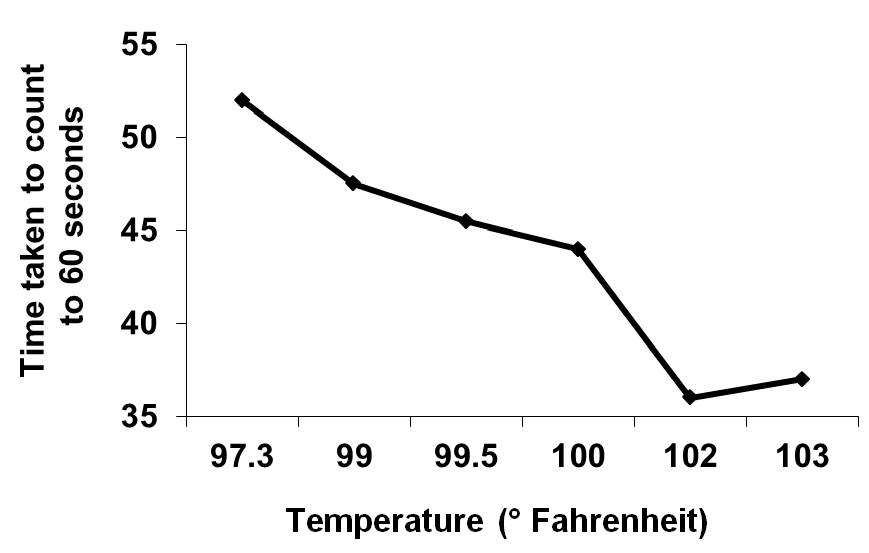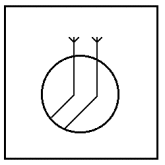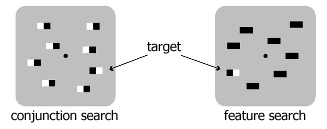
1. What are the different kinds of elementary temporal experiences?
2. What is the perceptual moment, and what is James’ Doctrine of the Specious Present?
3. Describe the biological basis for the circadian rhythm.
4. What is Hoagland’s hypothesis, and what factors affect our biological clock?
5. What are some estimates of the duration of the perceptual moment?
6. What is the difference between prospective and retrospective judgments of protensity?
7. How does Information-Storage Size Theory explain time perception?
8. What are the components of Cognitive-Attentional Theory?
9. What other factors affect time perception
Time is the most common English noun in newspapers, journals, fiction, and blogs on the internet (Concise Oxford English dictionary, 2006), and produces over 25 billion search results on Google.
Ernst Pöppel (1978): elementary temporal experiences:
• simultaneity
• successiveness
• temporal _____
• subjective _______: the feeling of “nowness”
• temporal continuity
• subjective duration (or __________): depends on mental load and attentional demand
Coren et al. (1999):
- basic unit of perceptual experience is the _____ or __________ ______
- consists of a set of relations among objects and actions
- _______ is found in the timing of units
e.g., “man-eating _____” vs. “_____-eating man”
- perception is limited if the time dimension were lost
William James (1890):
- “the prototype of all conceived times is the specious present, the short duration of which we are immediately and incessantly sensible” (p.631)
- short-term (“_______”) memory, the perceptual moment, the present?
- doctrine of the ________ _______: the group of events we experience at any one time as “present” contains successive events spanning an interval
• What we see, we see as present.
• We see motion.
• Motion occurs over an interval.
• Therefore: What we see as present occurs over an interval.
- problem:
• we see a moving object in successive positions (not in simultaneous positions as a blur)
• therefore, at each position, the object must exist in a separate specious (or false) present
- study of the circadian rhythm: the body’s (˜daily) biological cycle
Jean Jacques d’Ortous de Mairan (1733):
- intrigued by opening and closing of __________ leaves
- tested whether this was simply a response to the ___
- confined plant to the ____
- rhythms of leaves continued in absence of ________
Nathaniel Kleitman & Bruce Richardson (1938):
- stayed in Mammoth Cave in Kentucky for 33 days
- went to sleep and woke up 1 ____ later each day
- confound: amount of artificial light exposure
Charles A. Czeisler et al. (1999):
- carefully controlled amount of _____ exposure
- free-running circadian rhythm found to be __ hours, __ minutes long
- reset by light each day (“________________”); light considered to be the primary _________ (“time giver”)
- retinohypothalamic tract connects eye to suprachiasmatic nuclei (SCN) of the hypothalamus
- SCN inhibits ______ _____ from producing _________, the “sleep hormone”
- melatonin synchronizes activity in some glands and organs that regulate biological cycles
e.g., core temperature varies 1 °C night-afternoon
Hattar et al. (2002):
- mice genetically altered to lack functioning rods and cones still showed entrainment
- __________: photosensitive pigment found in retina, in some RGCs
- used fluorescence-labeled antibodies for melanopsin
- attached to about 2% of retinal ________ cells (somas, axons, and dendrites)
- stained proteins that traveled down the axons:
• showed projections to SCN
• and _______________ _______ (IGL) of LGN, which connects to SCN
Amount of light needed to reset the circadian clock in humans believed to be 1,000 lux.
However, timing, duration, number, and pattern of exposures to light are also important.
Wavelength is also of critical importance: strong melatonin suppression produced by 460 nm (colour of the ___).
Biological clock: internal mechanism for perceiving time
Hudson Hoagland (1933, 1935):
- had feverish ____ count to 60 to “measure” 1 minute
- perceived duration depended on ___________:

- higher temperatures speeded up subjective time perception (“time ______”)
- Hoagland’s hypothesis: brain has a biological clock that regulates metabolism, which affects perception of time
Baddeley (1966):
- tested _____ ______ off the coast of Wales in March; water was 4 °C
oral temp (°F) |
time judged as 60 sec |
|
before diving |
97.39 |
64.48 |
after diving |
95.03 |
70.44 |
difference |
2.36 |
-5.96 |
- being colder slows down subjective time perception (“time _____”)
Effects of drugs:
• stimulants (e.g., amphetamines, cocaine, caffeine) speed up internal clock (time crawls), resulting in an overestimation of time duration
e.g., when asked how much time has elapsed after 60 seconds have passed, will respond “90 seconds”
(but when asked to press a button for 12 seconds, will press it for only 8 seconds)
• depressants (e.g., alcohol), anesthetics, and some hallucinogens (e.g., THC) slow down internal clock (time flies), resulting in an underestimation of time duration
e.g., when asked how much time has elapsed after 60 seconds have passed, will respond “45 seconds”
(but when asked to press a button for 12 seconds, will press it for 16 seconds)
Rao et al. (2001): brain areas
- used fMRI to scan 17 volunteers
- task: two-alternative forced-choice:
• duration between first pair of tones vs. second pair
• were durations same or different?
- control tasks: hearing tones, estimating _____
- _____ _______, right parietal lobe involved--not cerebellum
- basal ganglia neurons primarily ____________
Implications: may aid understanding of disorders with impaired time perception:
• ___________ disease: abnormal reduction in dopamine within basal ganglia
• ____________ disease and Attention-Deficit/Hyperactivity Disorder (ADHD) believed to have abnormal basal ganglia function
• damage to right parietal lobe linked to impaired time perception
• _____________: hypothesized to involve abnormal dopaminergic neurons
- many schizophrenic symptoms may involve timing disorders
- when a movement or internal monologue seems to happen before you initiate it, your brain credits an outside cause
- short-term intervals are not dependent on SCN or 24-hour clock
- candidates include: neural activity, heartbeats, breathing, hormonal/metabolic activity, _______
- how long is the perceptual moment?
- Mach (1865): measured Weber’s law in temporal perception; observed that 30 ms is the lower limit for subjective durations
- well-trained motor tasks (e.g., typing, playing piano): about 30 ms
White (1963):
- presented clicks at different _____
- observers estimated rate
- high accuracy up to 5 clicks/second
- rates of 25 clicks/second estimated to be only 6 or 7 clicks/second
- perceived rate: 1 stimulus per ___ ms
Efron (1967):
- presented two pulses of light: standard was 1 ms, comparison varied
- task: which was ______?
- both perceived as equal, until comparison reached 60-70 ms
Perceptual moment is likely different for each ________, and different _____.
e.g., ______ in audition: ~2 ms, in vision: ~40 ms
Paradigms for time judgments:
• ___________ timing: observers are informed in advance that they will have to make a judgment about time
• _____________ timing: after an event, unexpectedly, observers are asked to make a judgment about time
Karl von Vierordt (1868): Vierordt’s Law
- when estimated retrospectively:
• short intervals of time tend to be overestimated
• long intervals of time tend to be underestimated
- point of ____________: duration of time at which perception of time (or “time sense”) matches interval of real time (~3 seconds)
John H. Wearden (2005):
Part I: participants placed into one of two groups:
a) watched 9 minutes of __________
b) spent 9 minutes in a simulated waiting room
- then they judged how quickly time seemed to pass (compared with some subjective “normal” condition):
a) time passed ______ than normal
b) time passed more ______ than normal
- that is, “time flies when you’re having fun”
- this implies that the Armageddon period seemed shorter than the waiting period, as time passed subjectively quicker in a period that was physically the same (although no judgment of duration was required)
Part II: all participants read a novel for 10 minutes
Part III: participants made _____________ time judgment of Part I
a) time spent watching Armageddon was judged to be ______
b) time spent waiting was judged to be _______
(difference between groups: about 10%; both groups estimated that the time was less than 9 minutes)
Results match storage-size theory:
- a time period (condition a) seems to fly when participants are in it (_______ of time judgment)
- but is judged as relatively long after it has finished (_____________ time judgment)
- in looking back, more things are remembered to have occurred, and thus more time seems to have passed
Sackett et al. (2010):
- participants told they would have 10 minutes to do a _______ task: underlining words with double-letter combinations (e.g., epigrammatic)
• group a): told 10 minutes was up after 5 minutes (time manipulation: time flew)
• group b): told 10 minutes was up after 20 minutes (time manipulation: time dragged)
- group a) reported task was ____ enjoyable, engaging, and fun
- further studies showed that, when time flew:
• irritating noises (dot matrix printer) were less bothersome
• and songs (e.g., “Crazy” by Gnarls Barkley) were more enjoyable
- conclusion: subjective duration of time is used in hedonic evaluation, or: “if time flew, you had ___”
David M. Eagleman & colleagues (2007):
- does time “slow down” or dilate during a frightening event, due to increased temporal resolution?
e.g., during a car crash, do things seem to happen in “slow motion”?
- graduate students wore a display (“perceptual chronometer ,” a.k.a. the “Eagle eye”) on their wrist which presented numbers in rapid succession
- display was adjusted so that the digits flickered too quickly to be identified under normal conditions
- participants fell 31 m (over 100 feet) from a scaffolding into a safety net (“Nothin’ But Net” at Zero Gravity Thrill park in Dallas)
- results:
• time ________: estimates of duration were 36% longer than they actually took (2.49 s)
• temporal __________ while falling was no different from that while on the ground
- time perception is not unitary, but is made up of different components
- speculation: time dilation during a frightening event may be due to a richer encoding of ______, which may cause a salient event to appear, retrospectively, as though it lasted longer
Information-Storage Size Theory (Ornstein, 1969):
- the amount of information picked up consciously and stored in memory determines perceived length of time
- amount of information processed depends on:
• ______ vs. unfilled intervals
- expectancy ![]() increased vigilance
increased vigilance ![]() greater temporal awareness
greater temporal awareness ![]() longer perceived duration
longer perceived duration
• number of ______
- a constant interval is judged to be longer, the more sounds that occurred (filled duration illusion)
• stimulus __________
- seeing shapes with more internal angles ![]() longer perceived duration
longer perceived duration
- familiar/___________ tasks ![]() accurate time perception
accurate time perception
• __________ of coding and storage
- more information retained ![]() longer perceived duration
longer perceived duration
- less information retained (or retained more efficiently) ![]() shorter perceived duration
shorter perceived duration
Mulligan & Schiffman (1979):
- presented ambiguous line drawing (“_______”) for 60 s

- task: study and remember it, then judge duration using magnitude estimation
- time interval was judged 16% shorter if preceded (or followed) by a cue
- implication: cue activates a schema for the drawing that reduces its complexity and allows greater efficiency of processing
Cognitive-Attentional Theory (e.g., Thomas & Weaver, 1975; Underwood, 1975; Zakay, 1989):
- focus of _________ directly affects temporal experience
- attention is divided between:
1. ___________ information processor: handles ongoing cognitive events
2. _________ timer: processes temporal information
- attention divided between doing the task, and estimating time
- more attention given to ____ ![]() greater perceived duration
greater perceived duration
- absorbing activities requiring effort: more information processing, less temporal awareness ![]() time _____
time _____
Chaston & Kingstone (2004):
- participants performed prospective time estimation for a visual search task:
• feature search: should not demand attention
• conjunction search: should demand cortical ___________ engagement

- after a block of trials, participants gave a written estimate of block ________
- ___________ search resulted in large underestimation of time
- also, as attentional demand increased (by increasing the number of ___________ in the conjunction search), so did underestimation of time
- conclusion: time _____ when you’re busy
- #10 in Popular Science magazine’s (2006) “science confirms the _______” list
______: more emotional events may seem to take longer
e.g., staring at an _____ face for five seconds feels longer than staring at a neutral one
Angrilli et al. (1997):
- presented emotional slides from International Affective Picture System, which are rated for _______ (direction) and _______ (intensity)
- valence: negative (___________), positive (pleasant scenes), neutral (_________)
- presented for 2, 4, and 6 sec
- estimated duration, or reproduced interval by pressing button
• low-arousal stimuli: negative slide duration was judged _______ than positive slides
• high-arousal stimuli: negative slide duration was judged ______ than positive slides
- arousal may control both emotional and attentional mechanisms
_____:
Frassinetti et al. (2009):
1. adapting phase:
- participants wore prismatic lenses, which induced a 10° shift of the visual field left or right
- performed several different spatial-orienting tasks
(e.g., pointing to a pen on top of a box)
2. aftereffect phase:
- visual scene appeared to be shifted in the opposite direction of adaptation
- participants asked to estimate time intervals (e.g., how long a coloured square appeared on a computer screen)
Results:
- inducing a rightward orientation of visual/spatial attention produced an ______________ of time intervals
- a leftward orientation created an _______________ of intervals
Conclusion: temporal intervals are represented (horizontally) in _____.
All human cultures use a spatial metaphor for time (Cooperrider & Núñez, 2016).
___: time seems to pass faster as we age (Joubert, 1990); proposed mechanisms
- neurological/physiological changes
e.g., decrease in ________ throughout adulthood may influence time perception
- the brain works harder to deal with novelty; upon reflection, periods of increased activity seem to last longer
e.g., an elderly person who has “seen it all before” may experience time as passing by more quickly
- we pay less attention to time as we age
e.g., kids count down the days to their birthday
- time pressure/______
e.g., research shows that if you feel there is not enough time to get things done, time is passing more quickly
- lifetime may serve as a reference level
e.g., a year for a 4-year-old is 25% of her lifetime; a year for a 60-year-old is about 2%
The experience of time results from complex interactions among endogenous __________ variables, factors occurring during the interval, as well as _________ processing and appraisal.